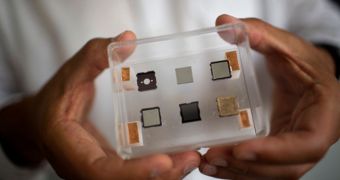Massachusetts Institute of Technology (MIT) associate professor of aeronautics and astronautics Paulo Lozano recently designed and built a penny-sized rocket thruster. The expert says that the device may be used to power tiny satellites as they make their way through Earth's orbits.
Even more remarkable, the chip-like thrusters are in fact ion engines, which have nothing in common with their larger, bulkier counterparts. There are no pipes, fuel tanks or valves on these thrusters, only an array of 500 microscopic tips.
When an electrical current is passed through these tips, they release ions, and this is what provides propulsion. Thrust basically comes from a rather small puff of charged particles, the scientists explains.
Since they come in the form of a flat, compact square, the new microthrusters can be installed aboard CubeSats and NanoSats without any problems. In fact, using them would clear up more space for other payloads, Lozano believes.
The expert imagines his invention powering a satellite about the size of the shoe box. “They’re so small that you can put several [thrusters] on a vehicle. [They could help a satellite] not only move to change its orbit, but do other interesting things – like turn and roll,” he says.
Lozano developed the devices together with colleagues and collaborators at the MIT Space Propulsion Laboratory, and the Microsystems Technology Laboratory. The microthrusters were just presented at the Joint Propulsion Conference, organized by the American Institute of Aeronautics and Astronautics.
At this point, more than 24 Rubik's Cube-sized satellites are orbiting the planet. Though they cannot compete with the capabilities of behemoths such as ESA's former Earth-monitoring spacecraft, Envisat, they can return useful data. On the upside, they are extremely cheap to assemble and launch.
Over the coming years, the market for CubeSats and NanoSats is expected to increase significantly. These microthrusters could potentially power an entirely-new generation of such spacecraft.
At this point, these small vehicles do not feature propulsion systems. They are deployed in low-altitude orbits for short periods of time, and are then destroyed, after their pathways decay. They usually burn up high in Earth's atmosphere. The microthrusters could change that.
Additional applications are also possible. A CubeSat powered by a microthruster could potentially nudge a larger, decommissioned satellite just enough to force it into reentering the atmosphere. In this manner, the tiny vehicles could be used to clean up Earth's clogged orbits.

 14 DAY TRIAL //
14 DAY TRIAL //